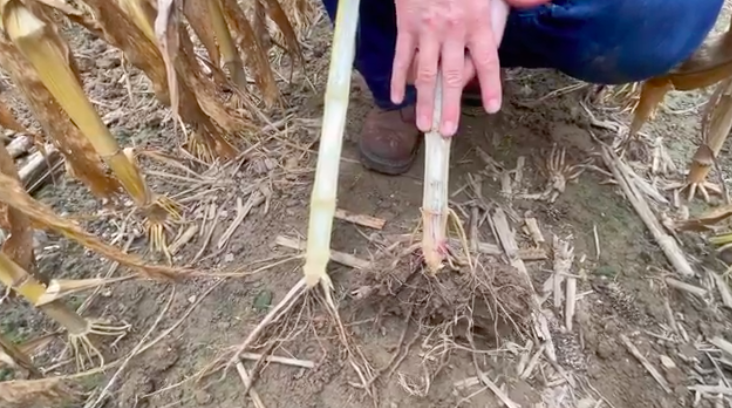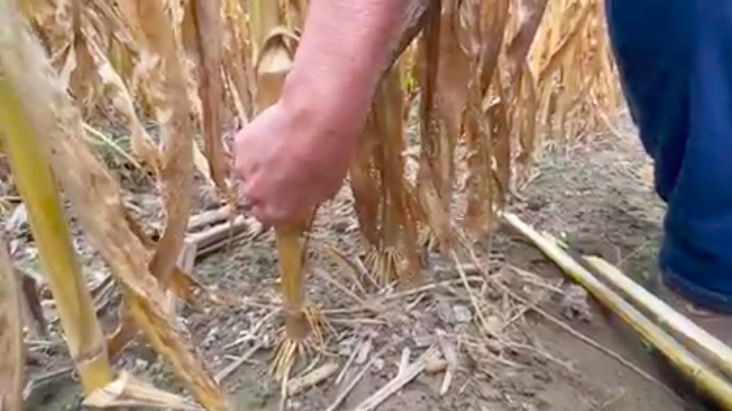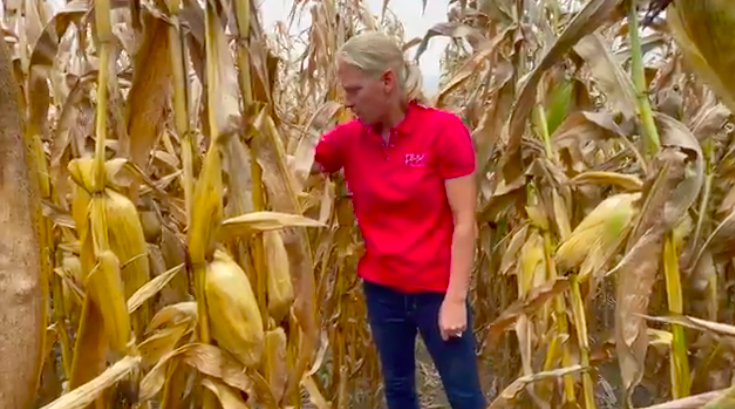Farmers Faced with Yields Cut in Half, Missy Bauer's 3 Tips to Salvage Fields Tormented By Tar Spot
Tar Spot 9/21/21 Missy Bauer in Field
Tar spot is tearing through Midwest cornfields, causing quick maturity and a massive reduction in yields in some corn hybrids. The corn disease shows up as small, raised black spots scattered across corn leaves. When conditions are right, it causes susceptible hybrids to suffer severe yield loss, a problem that’s playing out across the Midwest this year.
“There are a lot of fields with heavy tar spot pressure, which caused premature plant death. The earlier the fields died, the bigger the yield reduction we're seeing now,” says Missy Bauer of B&M Crop Consulting, who's also Farm Journal's Associate Field Agronomist. “We are hearing a lot of reports of 60 up to even 100 bushel per acre yield hits, where these plants really got killed prematurely from the tar spot.”
Bauer says the high humidity and wetter conditions this summer were two factors that fueled an environment for tar spot to explode.
First documented in the U.S. in 2015, the plant disease is fairly new, but the issue started surfacing in August this year. And heading into harvest, Bauer says it’s almost unbelievable to see how big of an impact tar spot is having on yields. In some cases, she’s seen irrigated corn fields yielding half of what the farmer would normally see. And she says it’s all rooted in kernel size, not ear size.
“Most of the ear size as far as kernel count has been really similar to previous years. Our issue is we had no plant health, no plant greenness to actually fill these kernels,” Bauer says, standing in a field impacted by tar spot. “When you think about kernel size, and kernels per bushel, we have a huge difference between where this tar spot has prematurely killed these plants.”
The Harvest Dilemma
Farm Journal Field Agronomist Ken Ferrie says the amount of tar spot in Illinois fields is unprecedented. In a recent “Boots in the Field Report,” he pointed out heavily infected fields, particularly those with D hybrids, have essentially progressed from August 31 to October 31, roughly a week’s span – and not in a good way.
Irrigated farm fields in Michigan that showed a lot of promise heading into harvest are quickly seeing the storyline change. USDA’s latest Crop Progress Report shows 2% of the Michigan corn crop is harvested, one point ahead of average. And how quickly a field can be harvested may be the difference in salvaging what’s left, versus losing even more crop in the field.
“What we're trying to do from here is really just prevent harvest disasters as far as down corn,” explains Bauer. “A lot of this corn is starting to go down, because there's no integrity left in the stalks. We're just one more storm or one more wind event away from a lot more corn falling down. So, what you need to do is get out and do some scouting and prioritize your harvest plan for which fields are getting harvested first.”
Three Steps to Prioritize Harvest and Minimize Yield Loss
Bauer says there are three main tests a farmer should be doing if he or she sees tar spot in the field.
- The first step is to split the actual stalks open to gauge stalk health, says Bauer.
“When you split these stalks open this time of the year, we should still see some integrity down in these stalks,” Bauer says, showing a stalk she split open. “You can see that there's still some plant juices down in here, so it's not what we call cannibalized. If it's cannibalized, it has turned into Styrofoam appearance and there's no integrity left in here.”

- The second step is to do what Bauer calls the “pinch test.”
“Down here at the base of these plants, just take your thumb and your fingers here and try to pinch these together, and you can hear that crack, and a lot of these out here in this particular field are doing that,” she says.

- Another key test, the “push test,” can help farmers see which hybrids are more susceptible to falling over due to tar spot.
“You grab the plant right about the height of the ear, and I want you to extend the stalk over toward the other row a full arm length, says Bauer. “When these are just snapping off, and they're not coming back at us, then we know we've got a greater potential for that down corn. You can see here, I've got several in a row that are just snapping off. That's not what we want to see right now at the front side of harvest, being that we're still in September.”

Bauer says the extent of the damage from tar spot is very hybrid specific, but by farmers scouting fields and seeing which fields are more susceptible to falling down, it will help them prioritize their field harvest order. At this point, Bauer says that’s the best recommendation to avoid even more yield loss in fields.







